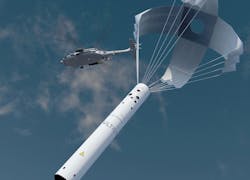Navy seeks to boost anti-submarine warfare (ASW) capabilities of multistatic, active, and passive sonobuoys
PATUXENT RIVER NAS, Md. – U.S. Navy anti-submarine warfare (ASW) experts are boosting the capabilities of naval air-launched sub-hunting sonobuoys to counter advanced nuclear-powered and air-independent propulsion enemy submarines.
Officials of the Naval Air Systems Command at Patuxent River Naval Air Station, Md., announced a collective $5.1 billion order earlier this month to three sonobuoy manufacturers for improved bathythermograph, passive, active/passive combo, multistatic source, multistatic receiver, and special mission sonobuoy capabilities.
This order involves the Lockheed Martin Corp. Rotary and Mission Systems segment in Manassas, Va.; Ultra Sonobuoy Systems in Columbia City, Ind.; and Sparton, an Elbit Systems of America company, in De Leon Springs, Fla.
Bathythermograph capability, such as that of the SSQ-36 sonobuoy, provides vertical temperature profiles of the ocean layer for ASW and research, and is used widely in ASW operations to evaluate local effects of seawater temperature on sonar propagation and acoustic range prediction.
Passive capability, such as that of the SSQ-53 passive directional low frequency analyze and record (DIFAR) sonobuoy, uses multichannel directional piezoelectric ceramic transducer hydrophones that operate at depths of 90, 200, 400, and 1,000 feet to listen for potentially hostile submerged enemy submarines.
Aircraft can drop a pattern of sonobuoys that relay information back to the aircraft by radio link, to determine the exact locations of enemy submarines.
Active capability, such as that of the SSQ-62 directional command active sonobuoy system (DICASS) sonobuoy, uses active sonar pings for detecting and localizing submarines in preparation for attack. It can provide range and bearing to the target to fix position.
Multistatic source capabilities, such as that of the AN/SSQ-125 multistatic sonobuoys, helps sonobuoys work together with other Navy sonobuoys. The AN/SSQ-125 sonobuoy is a source in a multistatic field, and can generate a variety of waveforms, and is designed to work with the AN/SSQ-53F, AN/SSQ-77C, and AN/SSQ-101 (ADAR) sonobuoys.
A multistatic sonar system contains several spatially diverse monostatic or bistatic sonar components with a shared area of coverage, and enables Navy ASW operators to use sensor fusion to combine the power of the separate sonobuoys.
The AN/SSQ-125’s RF channel can be programmed to any of the standard sonobuoy operating channels. At any time after deployment, the AN/SSQ-125 can be commanded to change its operating parameters or depth (deeper only), generate a ping, or scuttle.
The three companies will compete for individual orders. Lockheed Martin will do the work in Manassas, Va.; Undersea Sensor Systems will do the work in Columbia City, Ind.; and Sparton will do the work in De Leon Springs, Fla. Work will be finished in September 2027.
For more information contact Lockheed Martin Rotary and Mission Systems online at www.lockheedmartin.com; Ultra Sonobuoy Systems at www.ultra.group/our-business-units/maritime/sonobuoy-systems; Sparton at www.sparton.com/products/sonobuoys, or Naval Air Systems Command at www.navair.navy.mil.
About the Author
John Keller
Editor-in-Chief
John Keller is the Editor-in-Chief, Military & Aerospace Electronics Magazine--provides extensive coverage and analysis of enabling electronics and optoelectronic technologies in military, space and commercial aviation applications. John has been a member of the Military & Aerospace Electronics staff since 1989 and chief editor since 1995.
